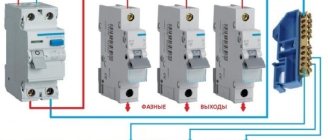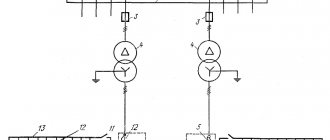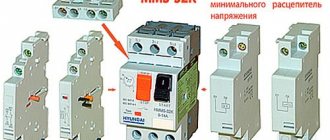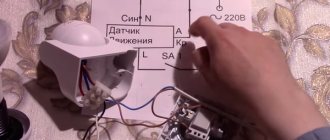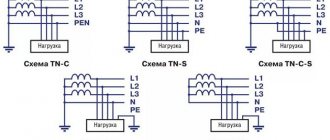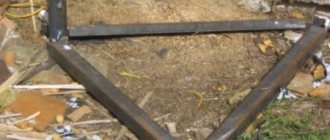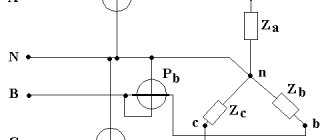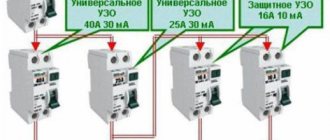Many, having heard that the RCD in the TN-C system does not work, are perplexed and often begin to prove the opposite. Critics' arguments, as a rule, are based on incorrect interpretations of definitions widely circulated on the Internet. Therefore, first, let’s define the TN-C system. Then we will explain in detail why the RCD does not work in TN-C, but works without grounding.
RCD in TN-C and without grounding are different situations
TN system is a system in which the neutral of the power source is solidly grounded, and the open conductive parts of the electrical installation are connected to the solidly grounded neutral of the source through neutral protective conductors;
TN-C system is a TN system in which the neutral protective and neutral working conductors are combined in one conductor along its entire length.
Before moving on to the consideration of the circuit from PUE 7, we highlight important points:
- All TN systems, including TN-C, must have protective grounding through PE neutral protective conductors.
- The entire length of the conductor mentioned in the definition of TN-C PEN should not be taken literally. When connected to an electrical installation, it will still be functionally divided into PE and N. And this is clearly shown in the diagram:
As you can see, the electrical installation is connected using L conductors, N and PE conductor, or (in some cases) using L conductors and PE conductor.
For reference, let's decipher the symbols of the conductors:
Why am I focusing on this? The fact is that many people simply do not understand the TN-C system. They read the definition, and based on the fact that the neutral protective and neutral working conductors are combined in one conductor along its entire length, they equate the two-wire wiring in the old housing stock to TN-C. But this is not true. As mentioned earlier, any TN system must necessarily have a protective grounding - in simple words, a PE conductor. In TN-C, which is a feature of economic feasibility, the PE conductor appears when dividing the PEN directly when connecting the electrical installation. Next comes the same PEN and the next electrical installation is connected to it, divided into N and PE. GOST 30331.1-2013 also states that electrical installations of residential and public buildings, retail establishments, and medical institutions are prohibited from being installed with the TN-C system grounding type.
Therefore, it is necessary to understand once and for all that there has never been, and is not, a TN-C system in residential buildings (apartments). And what we used to call two-wire in the PUE is called 3 to 220. Also, two-wire can be called a system without grounding, but not a TN-C system.
Having separated the TN-C system from the system without grounding, first of all we will consider why the RCD in the TN-C does not work, and then why in the system without grounding the RCD, although not particularly effective, does work.
Connecting an RCD - basic rules
1. The RCD is installed in the apartment electrical panel or in the panel on the floor;
2. In the RCD, as such, there is no protection against short circuits and overloads in the circuit. Therefore, to protect the RCD, it is installed in parallel with the circuit breaker. The tripping current of the circuit breaker must be less than the rated current of the RCD. With such a distribution of current ratings, in the event of an overload or short circuit, the circuit breaker will break the emergency circuit and the RCD will remain operational;
3. The circuit breaker is installed before the RCD, on the power side, and serves to protect the electrical wiring. The RCD protects the person, and the circuit breaker protects the electrical wiring;
4. It is allowed to install one RCD on several groups of electrical wiring with separate circuit breakers;
5. A circuit breaker is not required if, instead of an RCD, a differential circuit breaker is installed (differential circuit breaker - RCBO). For example, UZO-VAD;
6. When installing several RCDs for household appliances in a network, each RCD must have its own separate zero bus at the output. The buses of individual RCDs should not be connected to each other. If this is not done, then when one RCD is triggered, the others will also trigger;
Why the RCD does not work in the TN-C system
You can read about why RCDs are inappropriate and prohibited for use in the TN-C system in many books. Let's get acquainted with the material from the book “Protective grounding and grounding of electrical installations”, Mankov V.D., Zagranichny S.F. and then we will analyze everything in simple words.
Grounding of electrical installations in a single-phase electrical network of the TN-C system:
| Rпз | Re-grounding of the combined neutral working and neutral protective PEN conductor |
| Rз | Protective ground resistance |
| Io, Ipz, Iz, Ich | Currents flowing respectively through Ro, Rпз, Rз, Rч |
| Ikz | Short circuit current |
| Izn | Current through protective grounding |
| TV | Power supply |
In the above diagram, the crossed out RCD-D indicates the inappropriateness of its use in the networks of the TN-C system. This is due to the fact that the main currents caused by a short circuit will pass bypassing it, and the current through the protective grounding ( Izn ) prevents the formation of a current difference and the operation of the RCD.
The use of RCD-D in such networks is not permissible for two reasons:
- The short circuit current, which flows from the open conductive parts (cases) of the damaged electrical installation through a person, through Ro and Rpz into the PEN conductor, does not affect the residual current device as a differential (difference) current. For the RCD-D, the current ( Iкз ) will be indistinguishable and only a small part of it will return to the power source ( TV ) through the RCD-D. Current Is can flow to TV and through other electrical equipment, the housings of which (exposed conductive parts or third-party conductive parts) are accidentally or intentionally connected to a PEN conductor. In this case, the RCD-D does not work as protection against electric shock.
- If electrical equipment enclosures are grounded (zeroed) using a PEN conductor and the enclosures are in contact with ground, part of the load current may return to the power source through the ground under normal operating conditions. This part of the current will be perceived by the protective circuit-breaker device as a differential (difference) current and the device will operate if this part of the current passing through the ground is greater than the setting current of the protective circuit-breaker device.
Is grounding required for RCDs?
Many homeowners are confident that the protective device will work correctly only if there is a three-wire electrical circuit, with phase, neutral and ground conductors. For the same reason, the question often arises: which is better? RCD or grounding. In order to give the correct answer, it is necessary to understand the purpose of each of them.
It is known that the main function of an RCD is to turn off equipment when a current leak appears on the housing. Thus, it is possible to avoid electric shock to a person. Grounding is installed for the same purpose, only it works according to a different scheme. When electric current appears on non-current-carrying parts, a short circuit is created due to grounding. As a result, the maximum current protection of the machine is triggered and the equipment is de-energized.
Consequently, both methods of protection can be used separately, and, if necessary, together, complementing each other. Therefore, mandatory installation of grounding when using an RCD is not required and the protective device can be used even in a two-wire single-phase network in which there is no standard grounding. This conclusion is confirmed by the design of the device itself, where there are phase and neutral terminals, but there is no separate terminal for the ground wire. Particular attention should be paid to this, since grounding is mandatory only in modern houses.
In old houses, built during the Soviet era, two-wire networks are still used, without a grounding conductor. In such cases, protective devices are especially necessary. The only difference in the operation of an RCD with grounding and without grounding is only in the response time. In the presence of grounding, operation occurs almost instantly. An RCD without grounding is triggered only at the moment of touching the body of the device, which is energized. Therefore, the degree of protection is no longer as reliable as in the first option, but nevertheless, even in this case, the RCD protects against the unpleasant consequences of electric shock.
Leakage current and general protection circuit
For an apartment with TN-CS wiring, it would not be a mistake to take an RCD for 30 mA unbalance without unnecessary thought. A separate section will be devoted to the TN-C apartment system, but for private houses it is impossible to give clear and definitive advice right away.
According to clause 7.1.83 of the PUE, the operating (natural) leakage current should not exceed 1/3 of the RCD unbalance current. But in a house with electronic heated floors in the hallway, courtyard lighting and electric heating of the garage in winter, the operating leakage current can reach 20-25 mA with a living area of 60 and 300 square meters.
In general, if there is no greenhouse with electrically heated soil, a heated water well, and the yard is illuminated by housekeepers, at the input after the meter it is often enough to install a fire RCD with a rated current one step higher than the cut-off current of the machine, and for each group of consumers - a protective RCD with the same rated current. But only a specialist can make a clear calculation based on the results of electronic measurements of finished wiring.
Calculation examples
Let's look at how to calculate an RCD using examples for various cases.
1st – a brand new apartment with TN-CS wiring; According to the technical data sheet, the power consumption limit is 6 kW (30 A). We check the machine - it is at 40 A, everything is OK. We take the RCD one step or two higher in rated current - 50 or 63 A, it doesn’t matter - and for an unbalance current of 30 mA. We don’t think about the leakage current: the builders must provide it within the limits of the norm, but if not, let them fix it themselves free of charge. In general, contractors do not allow such mistakes - they know what replacing wiring under warranty smells like.
2nd. Khrushchevka, 16 A plugs. We install a 3 kW washing machine; current consumption is about 15 A. To protect it (and protect against it), you need an RCD with a rating of 20 or 25 A for 30 mA imbalance, but 20 A RCDs are occasionally available for sale. We take a 25 A RCD, but in any case, it is imperative to remove the plugs and replace them with a 32 A machine; otherwise, the situation described first is likely. If the wiring obviously cannot withstand a short-term surge of 32 A, nothing can be done, it needs to be changed.
In any case, it is necessary to submit an application to the energy service to change the meter and reconstruct the wiring, with or without replacement. This procedure is not very difficult and troublesome, and a new meter with an indication of the wiring status will serve you well in the future, see the section on malfunctions and defects. And the RCD registered during reconstruction will allow you to later call electricians for free for measurements, which is also very good for the future.
3rd. A cottage with a consumption limit of 10 kW, which gives 50 A. The total leakage according to the measurement results is 22 mA, while the house gives 2 mA, the garage - 7, and the yard - 13. We set the general difavtomat to 63 A cutoff and 100 mA imbalance, We power the house and garage separately through an RCD at 80 A nominal and 30 mA unbalance. In this case, it is better to leave the yard completely without its own RCD, but take the lighting fixtures for it in waterproof housings with a grounding terminal (industrial type), and connect their lands directly to the grounding loop, it will be more reliable.
Why is it necessary to install an RCD?
Let's look at this issue using a simple example. Let's say there is a washing machine in the bathroom. Electrical wiring in the apartment is made only with neutral and phase wires, there is no protective grounding, and the RCD is not installed.
Let us present the situation further. The insulating layer inside the machine was damaged, causing the phase to come into contact with the metal body. Some potential has appeared, that is, the body of the washing machine is now energized. If a person approaches it and touches it, it will play the role of a conductor through which electric current will flow. The effect of the current will continue until the person withdraws his hand from the washing machine, because the damaged area will not be turned off by any device. Unfortunately, under the influence of current, a person’s muscles are paralyzed, and it is not always possible to pull the hand away.
There are two options here - either the person loses consciousness and gives in, or someone else helps him by turning off the input machine for the room.
If, in the example considered, there was an RCD in the distribution panel, it would react to the appearance of a leakage current, turn off and protect human life. It is for this reason that in an apartment equipped with a large number of powerful household appliances, the installation of an RCD is simply necessary.
Types of electrical networks
The power supply to our apartments and houses comes from a single-phase or three-phase network.
Single-phase electrical power is one phase and zero. To power household appliances and lighting devices, you need phase voltage, which is obtained at the output after the step-down transformer. This single-phase power supply involves powering from one phase of the line.
Electric current moves through the phase conductor, and through the neutral conductor it returns to the ground. Most often, this type of electrical wiring is used in an apartment, and it has two varieties:
- Single-phase two-wire network (without ground). This type of electrical network can most often be found in old houses; it does not provide for grounding of electrical appliances. The circuit includes only a neutral wire, marked N, and one phase conductor, which is designated L.
- Single-phase three-wire network. In addition to the neutral and phase conductors, it also contains a protective grounding conductor, designated PE. The housings of electrical devices must be connected to grounding conductors; this will protect the equipment itself from burnout, and people from the action of electric current.
The house often contains equipment that requires three-phase voltage (pumps, motors, if there are machines in the barn or garage). In this case, the network will consist of neutral and three phase wires (L1, L2, L3).
Similarly, a three-phase network can be four-wire or five-wire (when there is also a protective grounding conductor).
We have decided on the types of networks, and now we will move directly to the question: is it possible to connect an RCD without grounding and how to properly install this device?
Is it possible to connect an RCD without grounding - on video:
The best schemes
In most networks that supply single-phase power to household loads, there is an RCD without grounding. For its normal operation, two wires are enough (phase and zero).
Features of circuits without grounding
The specificity of an RCD without grounding is due to the fact that when using it, an auxiliary protection device will be required that is triggered in the event of a short circuit. For this purpose, circuit breakers designed for the appropriate current setting are installed together with RCDs.
Additional information: Instead of a separate machine and RCD, a combination of them is often used, combined in the body of one device, which is called a difavtomat (the photo below shows an automatic machine, an RCD and a difavtomat).
This device provides for switching two conductors of the supply line at once (phase and zero). Moreover, both of them are connected to the corresponding contact. Only with this connection is it possible to implement the principle of operation of the RCD as a device that compares current components.
Classic inclusion
Typical activation of an RCD without grounding is possible only if there is an extensive network of load lines protected by a separate circuit breaker (there are only two such loads in the photo below).
Classic RCD connection diagram
Please note: A similar scheme is used when connecting RCDs to single-phase networks with grounding, which is why the degree of protection increases noticeably.
To get acquainted with the specifics of protection without grounding, it is most convenient to consider the circuit of a single RCD, in the load circuit of which one consumer is connected through a circuit breaker. Using his example, you can study the principle of operation of these systems, a description of which is given below:
The RCD here is installed immediately after the meter (electricity meter); Moreover, both phase and zero are supplied to its contacts. According to the requirements of the PUE, the wires must be connected to the upper terminals of the device (and not to the bottom block).
Conductors are routed from the contacts located below according to the following scheme:
- The red phase wire is laid to the top block of the machine (AB).
- The earth conductor in blue insulation is diverted towards the common zero strip (GZSh), which is mounted in the apartment panel regardless of the presence of full grounding.
- From the bottom terminal, the phase together with the zero bus with the main switch is diverted towards the linear load.
Before installing an RCD for apartments without grounding, you need to remember the following. It will certainly work only when leaks appear due to human touch or to a bare conductor or housing accidentally exposed to a dangerous potential.
Important! “If it is necessary to use an RCD to protect individual electrical receivers receiving power from the TN-C system, the protective PE conductor of the electrical receiver must be connected to the PEN conductor of the circuit supplying the electrical receiver to the protective switching device.” Excerpt from PUE clause 1.7.80.
Connection diagram of an RCD in a two-wire network in accordance with the PUE
Be sure to watch this video:
Which RCD connection circuit is preferable?
To evaluate circuits for connecting RCDs to single-phase networks without grounding, this formulation of the question is not entirely correct. It would be correct to put it this way: what level of security does each of the existing schemes for connecting an RCD to the protected line provide? To get the correct answer you will need to consider the following options:
- The simplest circuit (one RCD with a linear circuit breaker standing after it).
- Several parallel devices operating on single circuit breakers (group connection).
- Stepped or sequential connection of RCDs, each of which is designed for its own leakage value.
It is clear that the latter option is more effective than conventional RCD connections without grounding. However, due to the complexity of implementation and redundancy of protective functions in everyday life, it is used extremely rarely. The second most reliable option seems to be group connection, when each room is assigned a separate device in the form of a difavtomat (photo below).
Group activation of RCD
Important! This option is optimal for multi-apartment housing and private houses.
With this arrangement of switching on, each of the serviced lines will operate independently of the others, which will significantly increase the selectivity of the system as a whole. As a result, the safety of using electrical appliances in each room is noticeably increased.
The simplest way to connect an RCD without grounding was already discussed earlier when describing the classic version. It is usually used in rooms where the threat of damage is very low.
Scheme for a private house
Unlike urban housing, where local utilities are responsible for protecting power supply networks, in private housing all decisions are made by the owner of the house independently. In this case, the following options are possible:
- Use of three-phase supply circuits with RCDs of the appropriate class.
- Laying a single-phase network with group devices in each of the lines.
- Multistage systems of several series-connected devices with different current leakage values.
The procedure for connecting a three-phase RCD can be found in the diagram below. In this case, you will need a 4-pole device, switched on immediately after the electricity meter (also three-phase).
Connection diagram for 4-pole RCD
Please note: Connecting a three-phase network with grounding is required in cases where in the private sector it is planned to use power equipment designed for 380 Volts (machine tools or pumps, for example).
In their absence, the power supply networks of suburban buildings use conventional two-pole RCDs without a grounding circuit, operating according to the principle already discussed earlier.
The option of arranging a multi-level system that provides several sublevels of protection at once requires special consideration. The connection diagram for RCD circuit breakers in an apartment or private house can be found in the figure below.
One group RCD and four individual
It shows, as an example, a situation where one group device and four individual devices are used for protection.
In total, there are five devices with RCD “knocking out” leaks from 10 to 300 mA. The function of a group protection device against short circuit and fire is performed by a 300 mA and 63 Ampere device. Two universal RCDs, rated for 30 mA leakage, protect lighting lines and a group of power outlets (current cutoffs are 25 and 40 Amps, respectively).
Important! In damp rooms, where the threat of electric shock is particularly high, it will be necessary to install high-sensitivity devices with leakage currents of about 10 mA.
All remaining groups are divided into subnets; Moreover, in each of them the corresponding RCDs are installed (for the bathroom and children's room). Independent arrangement of such an extensive power supply system is associated with significant difficulties. That is why, when choosing a multi-stage layout of differential automatic machines, it is recommended to invite specialists for their installation.
Option for dacha farming
Modern dacha farms are increasingly approaching the infrastructure of full-fledged housing and most often have a fairly developed power supply system. The electrical protection of people living in such facilities must be at an appropriate level. According to current standards (the provisions of the PUE, in particular), the requirements for country houses in terms of protection against electric shock are not so high (if we compare them with city apartments).
This explains the fact that country houses traditionally use simplified protection circuits using universal RCDs (usually for leakage currents of about 30 mA). When choosing devices suitable for these purposes, preference is given to AV and RCDs combined in one housing (difavtomat). This combined protection against short circuit (cut-off currents are selected within 25 Amps) and electric shock is quite sufficient for the safe operation of country electrical equipment.
Please note: Three-phase power supply using 4-pole RCD devices with grounding is extremely rarely used in this case.
To equip it, you will need special permission from the dacha cooperative and the local branch of Energosbyt. If it is necessary to expand the power supply circuit of a summer cottage, it is allowed to install additional (group) 10 mA leakage protection devices (for sockets located on the veranda, for example).
Connection procedure
The general principle of connecting an RCD without grounding provides for compliance with the requirements of the PUE in terms of compliance with protective measures during electrical installation work. For this purpose, first of all, it is necessary to completely remove the power supply from the entire facility (turn off the input circuit breaker on the electrical panel) and stock up on working tools. The latter should include a set of screwdrivers and side cutters for stripping the ends of the wiring, as well as an indicator screwdriver.
The materials you will need are the device to be installed and a coil of copper wire insulated with a cross-section of at least 2.5 mm. In addition, you should prepare in advance an electrical installation diagram in a single-phase network, drawn up in full compliance with current standards.
All operations for installing a protective device are carried out taking into account the following important points:
- The protection device is securely mounted on the panel of the input electrical panel in the immediate vicinity of the electric meter and line machines.
- After installation, the device is connected according to the diagram using copper conductors of the selected cross-section (at least 2.5 mm).
- During the installation process, you should be guided by the connection diagram available on the device body.
- Upon completion of the installation operations, you must once again verify that the connections have been made correctly and try to supply power to the facility (turn on the input circuit breaker).
You can check the correct operation of the differential device using the special “Test” button. After pressing it, a special built-in mechanism will trigger the protection automatically. As a rule, a well-designed RCD in an apartment without grounding or a circuit breaker in a country house pass the test without any difficulties or difficulties. Otherwise, you will have to admit that the protection parameters were chosen incorrectly. The latter is manifested in the fact that clicking on “Test” does not trigger the RCD when an external load is connected.
Additional information: It is also possible to have a non-working (faulty) RCD or automatic circuit breaker, the condition of which can be checked by simply replacing it.
In this case, the device is replaced with a new product, and the old one is returned to the store or sent for repair.
How does an RCD work?
To better understand how an RCD works, first of all, you should familiarize yourself with its circuit design and internal structure. Regardless of the connection method ( RCD without grounding or with one), the operation of this device is based on the principle of comparing incoming and outgoing currents. For this purpose, it contains a differential unit through which currents I1 and I2 flow in different directions.
Operating principle of RCD
They create identical magnetic fluxes in the ferrite core coils, compensating each other. As a result, the differential signal does not affect the actuator, and the RCD remains in the on (closed) state.
In case of accidental contact with a bare wire, a leakage current Iу begins to flow through the body of a person or animal. As a result of this, the reverse component I2 flowing through the comparison organ decreases by this amount.
The balance of forward and reverse flows in coils F1 and F2 is disrupted, and a difference signal is sent to the actuator unit. After this, the RCD in the two-wire network disconnects the load from the supply line (the dangerous voltage disappears).
Connect without grounding
How to properly connect an RCD
Connecting an RCD in the absence of grounding is done quite often in many apartments and old houses. Since in old-style houses there are usually power cables with one phase and zero, it is not possible to connect grounding. To make grounding, you will need to install a grounding protective loop around the perimeter of the building, and be sure to change all the wiring in order to place a new cable with “ground”. Only connecting such a core to a special conductor for sockets or individual contacts on powerful household appliances will allow grounding to be done in an apartment or private house. By combining such protective measures together with an RCD and a circuit breaker, it is possible to provide a residential building with all the necessary measures to prevent accidents.
However, many people simply do not have the opportunity to replace all the wiring in the apartment, since today this is an expensive update. For this reason, an RCD without grounding is installed. Despite the fact that the electrical network is not grounded, you should not ignore the connection of the residual current device. The protective equipment itself does not have terminals for the grounding conductor. It has places for connecting a phase and a working zero. Since this device has a completely different purpose, there is no need to make separate grounding points for it.
Connection diagram for a two-pole RCD
A connected RCD in the absence of grounding is expected to cut off the supply of electricity to the network when the potentials of the incoming and outgoing current change. Therefore, if there is no grounding structure in the house and a three-wire wire is not installed, there is also no reason to refuse to connect other types of protective equipment. It is advisable to simultaneously install a residual current device and a circuit breaker. The latter device will prevent short circuits in an apartment or private house if the cable is damaged, as well as prevent burnout of household appliances during voltage surges in the electrical network. An RCD cannot protect or warn against such things. It is designed to prevent AC leakage in the circuit.
According to the Electrical Installation Rules (PUE), you cannot use RCDs that react to differential current in three-phase circuits with four wires (the grounding is combined with the working zero). If you install a residual current device on the entire electrical network, then this circuit will be simpler. When connecting an RCD without grounding, you must know the parameters of the power cable that is laid in a private house or apartment, as well as the total current value, when calculating the simultaneous connection of all household appliances to the network.
Typically, the installation diagram of protective equipment provides for sequential connection of all elements. Even if changes are made to the new circuit by adding a new source or element, the sequence should not be broken. In this case, it will simply be connected to the appropriate section of the electrical circuit. For single-phase electrical wiring in which there is no grounding conductor, the residual current device must be placed in front of the distribution panel and in front of the energy supply meter. Then there are circuit breakers (if there is more than one) and a voltage equalizer. If you follow this scheme, you can exercise full control of all the wiring in the house, and not just its individual branch.
For individual branches with powerful electrical equipment, circuit breakers are installed that will respond to high voltage without turning off the power supply throughout the house. The most common scheme for connecting an RCD is the one designed for a single-phase power cable with a voltage of 220 volts. If the owners want to install less powerful protective equipment on each line with powerful equipment, then such a scheme will have a slightly different look. It is recommended to make connections separately for the bathroom, garage or workshop, basement, and also for the kitchen. There are often large studio kitchens where quite a lot of electrical appliances are connected to the circuit at the same time. In such a situation, it is advisable to divide the residential building and adjacent premises into separate areas with electricity consumption, providing each with independent protection.
Conclusion
As already said at the beginning, RCD is not a panacea for the electronic threat. It repeatedly reduces the possibility of electric shock, but electricity still does not tolerate thoughtless and irresponsible handling of it.
The best option for developing electrical safety measures is the widespread use of chip sockets and electrical differential RCDs integrated into electrical installations. In this case, even the TN-C power supply system, while maintaining its efficiency, could become completely harmless.
Installation required
Modern protection devices are especially in demand in the following situations:
- If it is impossible to arrange complete grounding at the site.
- When increased demands are placed on its safety.
- When installing electrical equipment in areas with high humidity (in the kitchen, in the toilet and in the bathroom, in particular).
The presence of these devices guarantees reliable protection of a person exposed to dangerous potential.
Such guarantees are based on the peculiarities of the RCD operation, which turns off the supply circuit almost instantly (within tens of milliseconds). During this period of time, the current leakage through the body of a person or animal does not have time to reach a value dangerous to their life.
Appearance of the residual current device (RCD)
